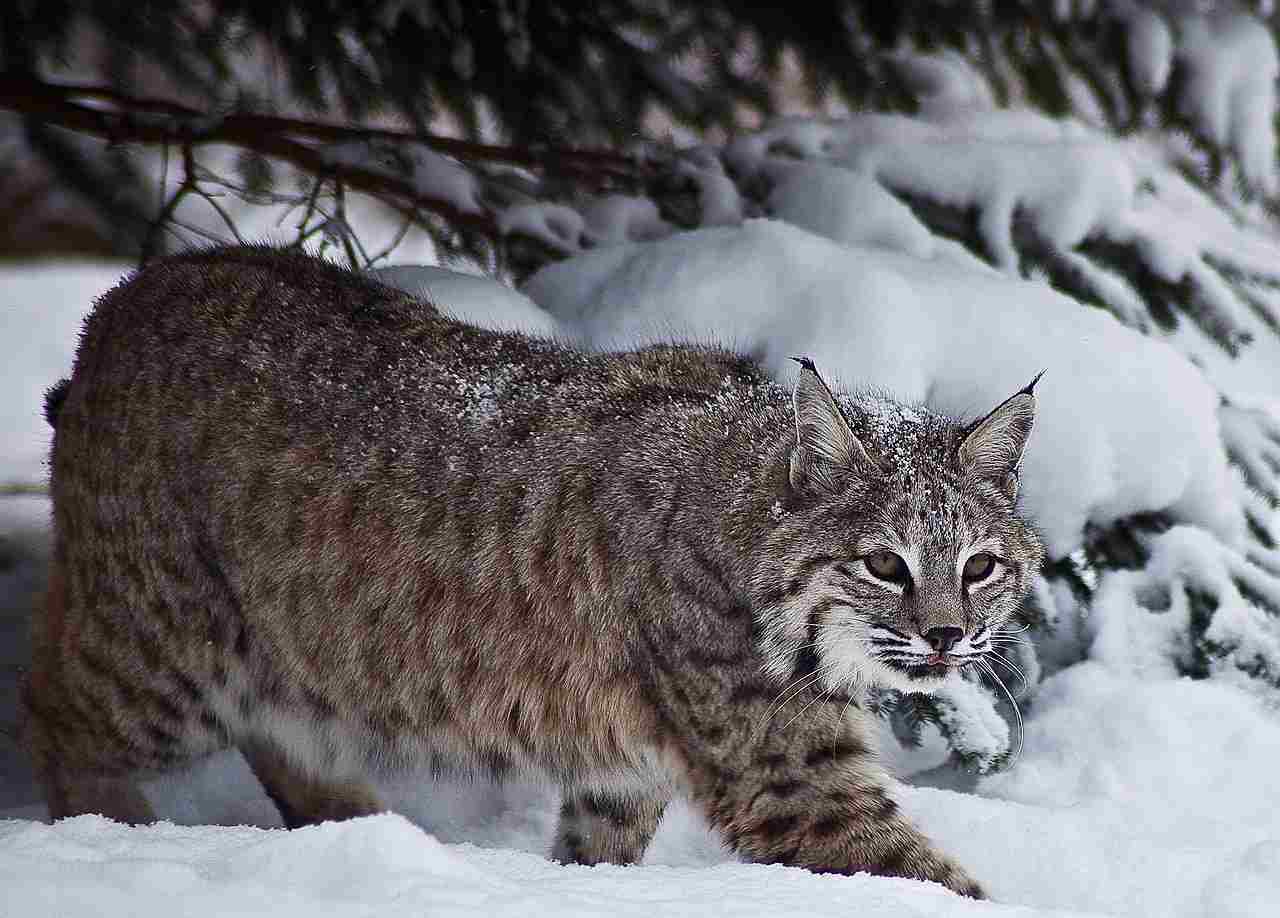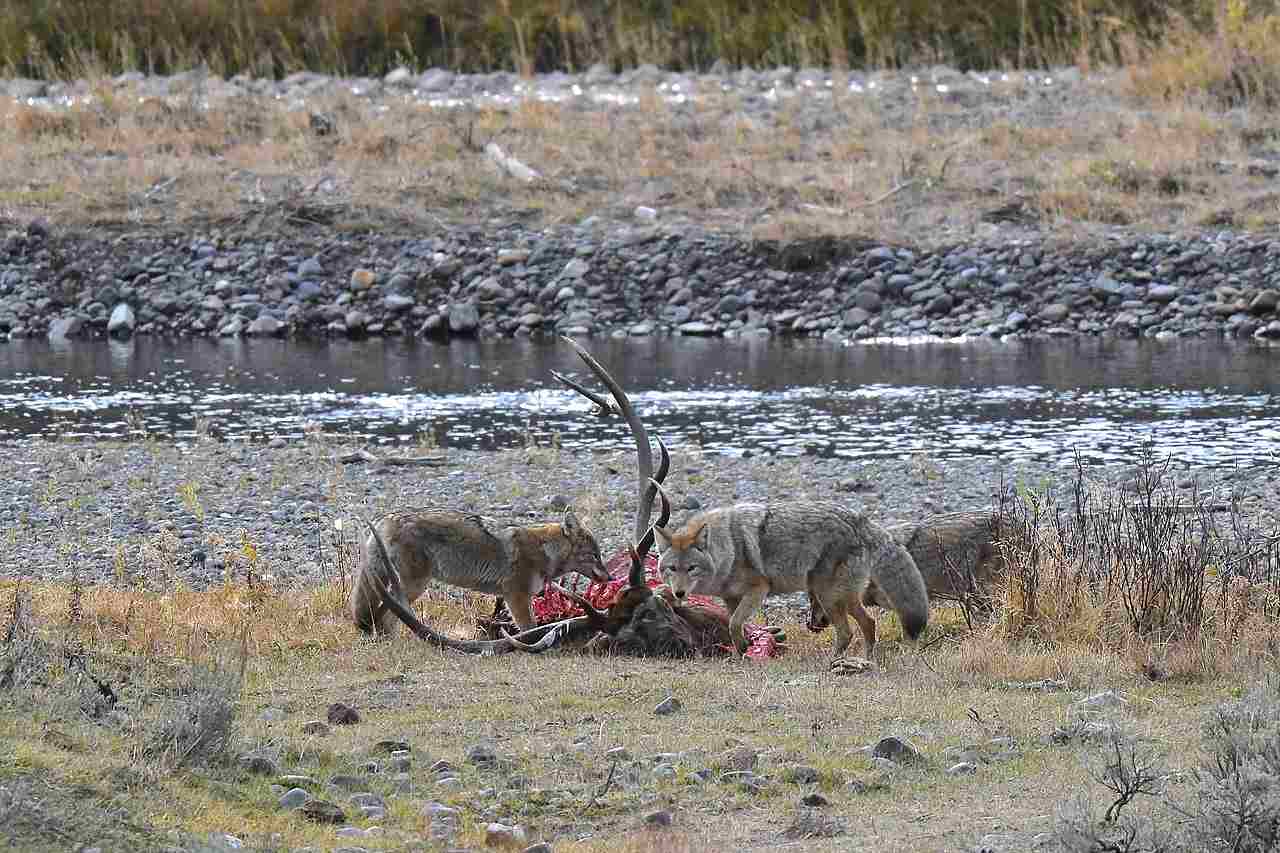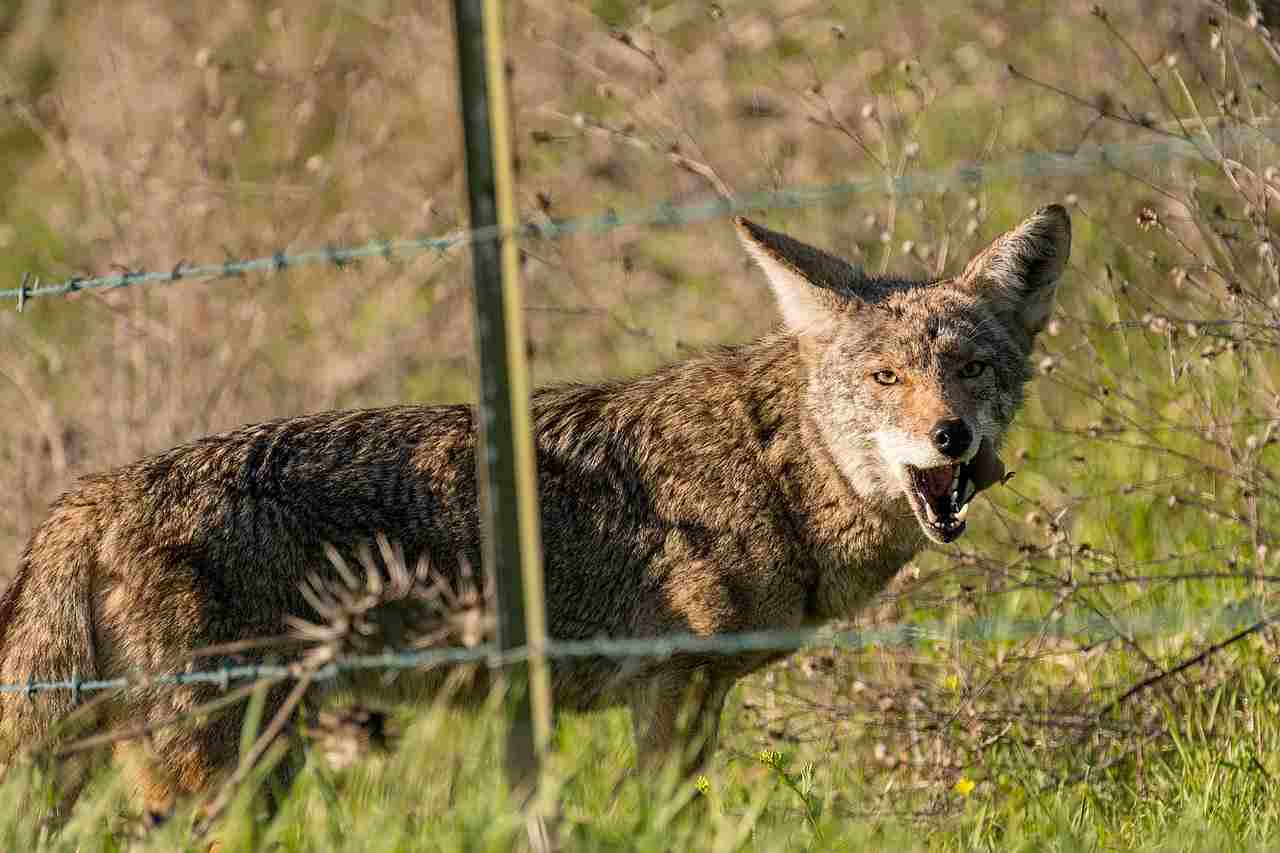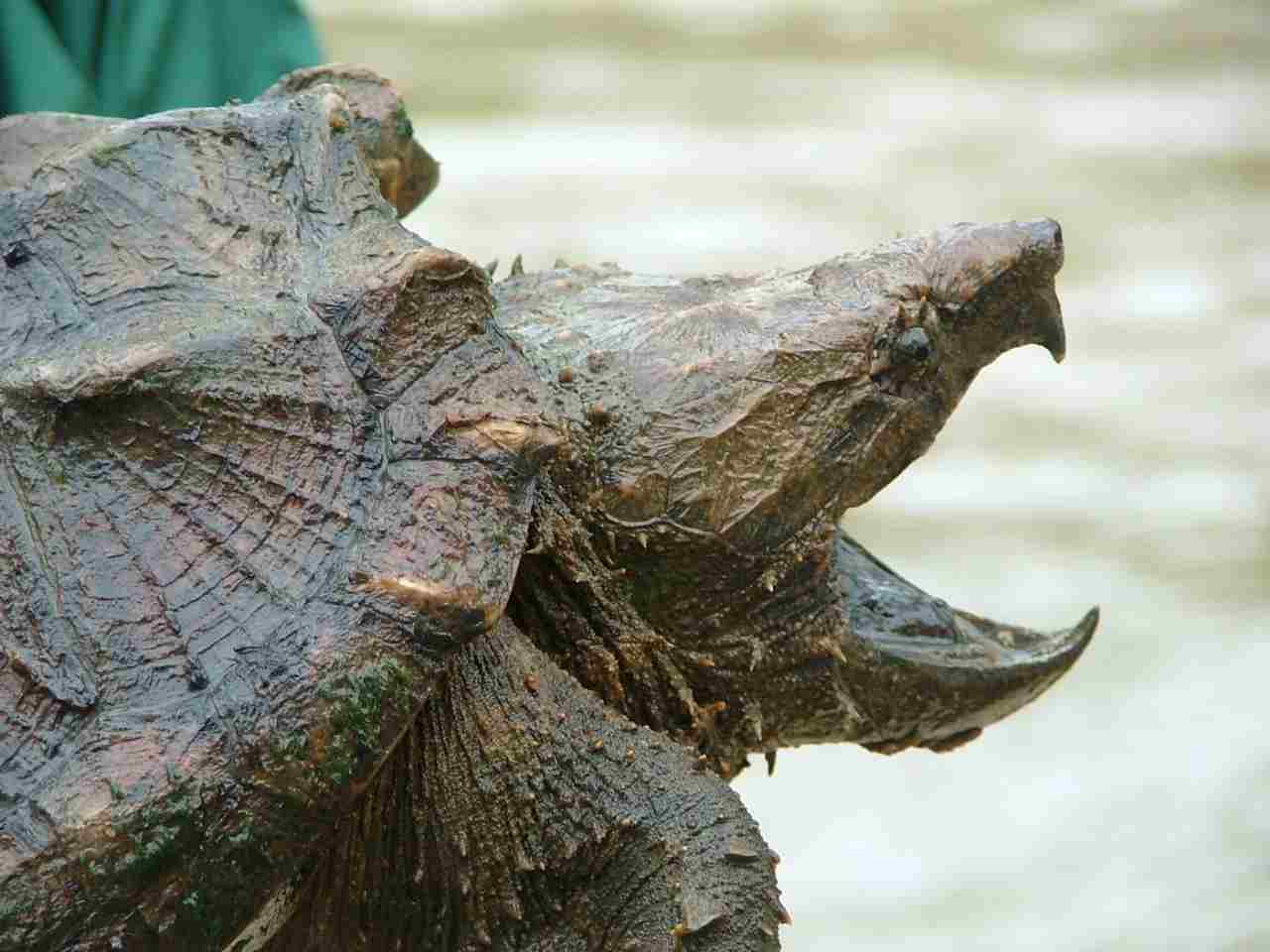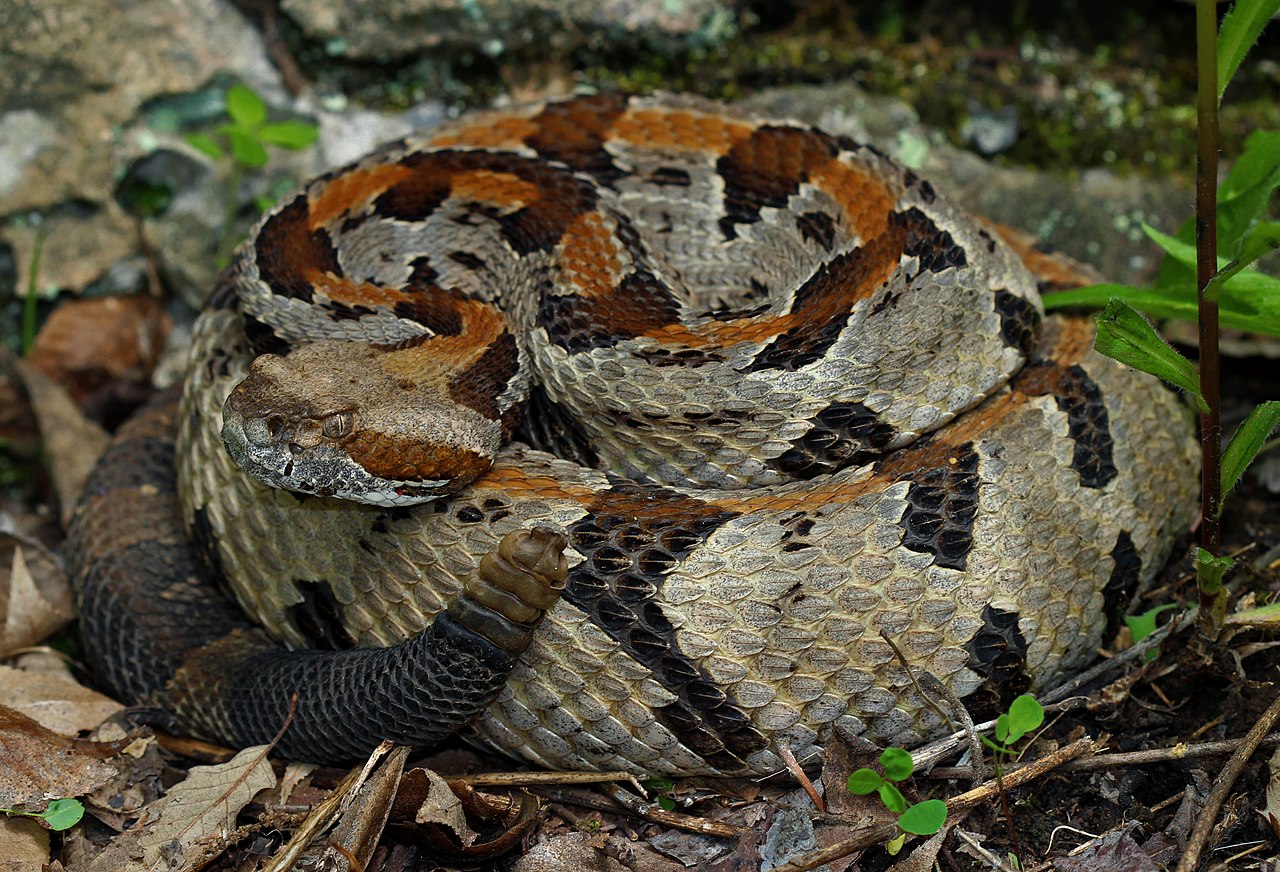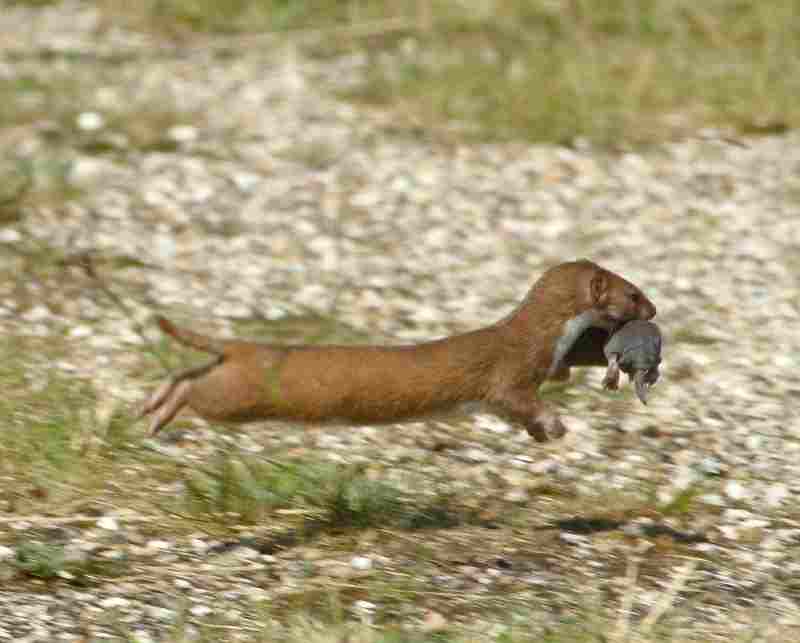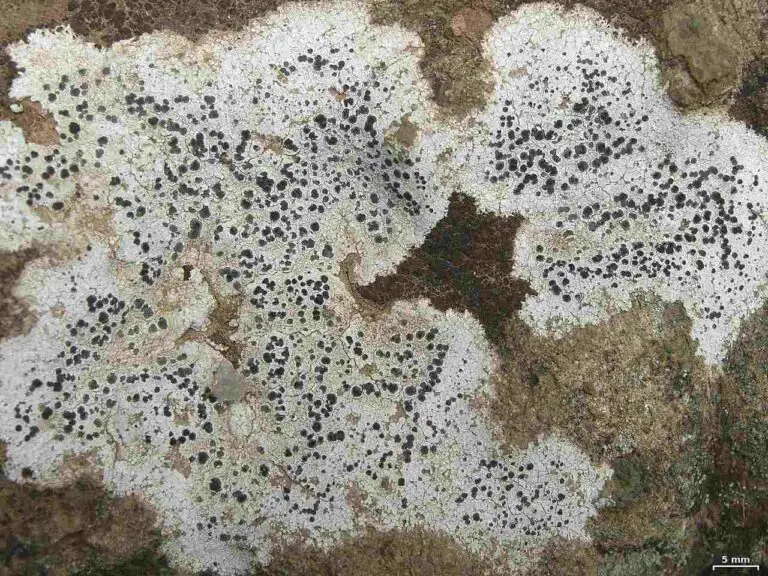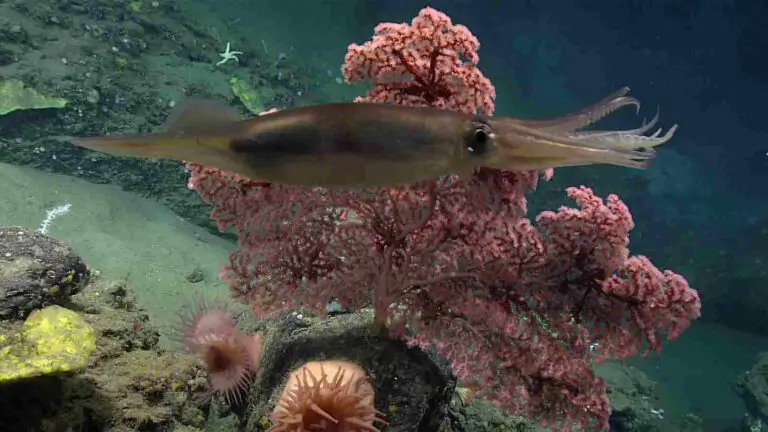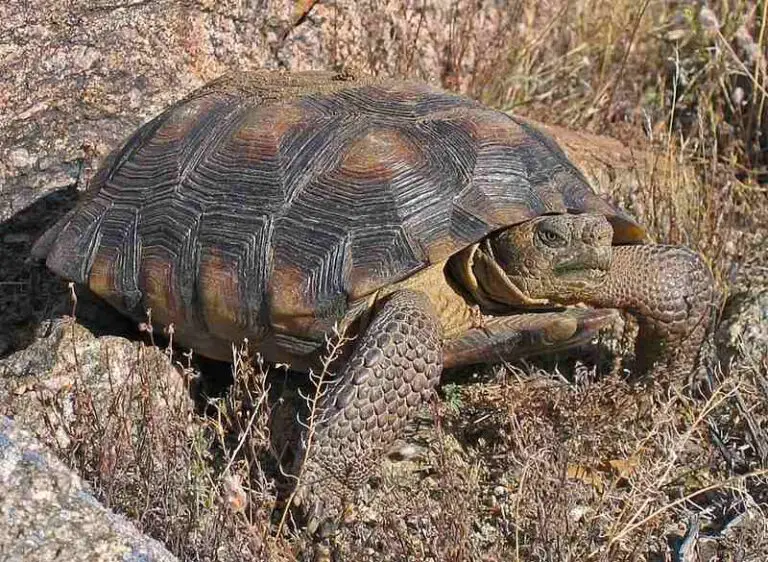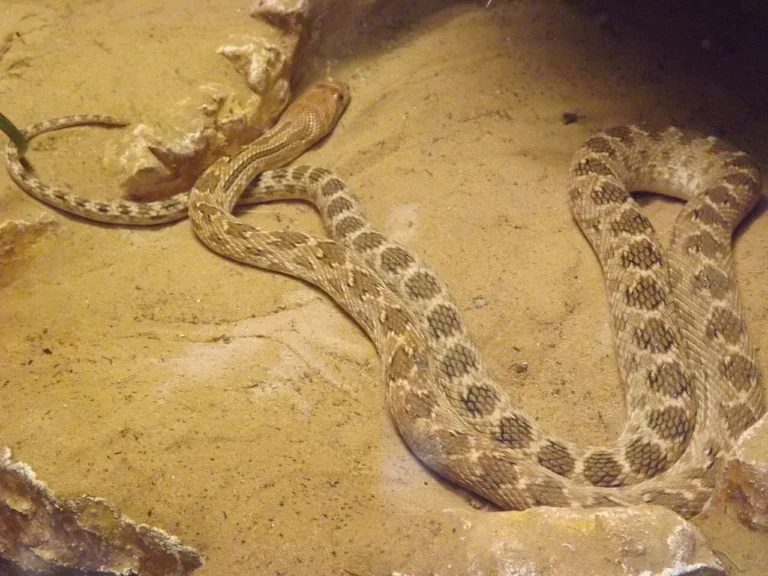25 Dangerous Animals In Ohio And Their Characteristics
1. Timber Rattlesnake
The Timber Rattlesnake (Crotalus horridus) is one of the most dangerous reptiles found in Ohio, known for its distinct rattle and potentially lethal venom. Generally found in the state’s wooded areas and rocky ridges, these snakes are usually reclusive, preferring to avoid human contact. However, when threatened or provoked, they can deliver a potent bite that requires immediate medical attention. Timber rattlesnakes are identifiable by their thick bodies, patterned scales, and the characteristic rattle at the end of their tails, which they use as a warning signal. While their venom is designed to immobilize prey, it can cause severe symptoms in humans, including intense pain, swelling, and, in extreme cases, life-threatening complications. Despite their dangerous reputation, Timber Rattlesnakes are a vital part of Ohio’s ecosystem, controlling rodent populations and maintaining a balanced environment.
2. Eastern Massasauga Rattlesnake
The Eastern Massasauga Rattlesnake (Sistrurus catenatus) is Ohio’s only venomous pit viper and is recognized as a threatened species due to habitat loss and human encroachment. This snake is smaller than its Timber counterpart, with a typical length of 18 to 30 inches, and is known for its gray and brown blotched pattern. It is found in wetland areas, meadows, and prairie ecosystems. Though not aggressive by nature, the Eastern Massasauga will rattle when threatened and can inflict a venomous bite that causes severe pain, swelling, and potential tissue damage. Despite their risk to humans, these snakes play a critical role in controlling rodent populations and are protected under state law, which makes it illegal to harm or kill them without proper authorization.
3. Copperhead Snake
The Copperhead Snake (Agkistrodon contortrix) is another venomous snake found in Ohio, named for its coppery-red head and distinctive hourglass-shaped pattern on its body. These snakes typically inhabit wooded areas, rocky hillsides, and forest edges. Although their venom is less potent than that of other rattlesnakes, a bite from a Copperhead can still cause intense pain, swelling, and other adverse reactions. Copperheads are generally reclusive and will only strike when provoked or accidentally stepped on. Despite their venomous nature, they contribute to maintaining ecological balance by controlling small mammal populations. It’s important to exercise caution in their habitats and avoid disturbing them to prevent dangerous encounters.
4. Black Widow Spider
The Black Widow Spider (Latrodectus mactans) is a notorious arachnid found in Ohio, instantly recognizable by its shiny black body and distinctive red hourglass marking on its abdomen. Although generally reclusive, Black Widows are considered dangerous due to their potent neurotoxic venom. Bites can cause severe pain, muscle cramps, nausea, and in some cases, life-threatening symptoms. These spiders are often found in dark, undisturbed areas like woodpiles, sheds, and basements. Despite their fearsome reputation, they play a role in controlling insect populations. It’s crucial to exercise caution when reaching into hidden spaces and to seek immediate medical attention if bitten.
5. Brown Recluse Spider
The Brown Recluse Spider (Loxosceles reclusa) is another venomous spider in Ohio, characterized by its brown color and distinctive violin-shaped marking on its back. Known for its reclusive nature, this spider often hides in dark, undisturbed areas such as attics, closets, and basements. Its venom contains a cytotoxin that can cause tissue necrosis and severe lesions, requiring prompt medical attention to prevent further complications. Although encounters with Brown Recluse Spiders are rare, they can lead to significant health risks if bitten. Precautions should be taken when handling items stored in dark areas, and immediate medical care should be sought if a bite is suspected.
6. Coyotes
Coyotes (Canis latrans) are adaptable carnivores found throughout Ohio, known for their intelligence and resilience. Although generally shy and cautious around humans, coyotes can pose risks to pets and small livestock, particularly when natural food sources are scarce. They are typically active at dawn and dusk, and their distinctive howls and yips are often heard at night. Coyotes play an essential role in controlling rodent and small mammal populations, but human encroachment has led to increased encounters. To reduce risks, it’s important to keep pets indoors at night, secure trash cans, and avoid leaving food outside. Coyotes are protected by law, and lethal control measures require appropriate permits.
7. Bobcats
The Bobcat (Lynx rufus) is a medium-sized wild cat native to Ohio, recognizable by its tufted ears, short tail, and distinctive spotted fur. Generally elusive and rarely seen by humans, bobcats pose minimal threat to people but can be a risk to small pets and livestock. They inhabit forested areas and swamps, hunting small mammals, birds, and reptiles. Bobcats are important predators in Ohio’s ecosystem, contributing to the control of prey populations. Though they are not commonly encountered, if a bobcat appears aggressive or overly bold, it may be sick or injured, and professional wildlife authorities should be notified.
8. American Black Bear
The American Black Bear (Ursus americanus) is the largest mammal found in Ohio’s forests, generally reclusive and avoiding human contact. Although black bears are not typically aggressive, they can pose significant risks if they feel threatened or are protecting their cubs. Black bears are opportunistic feeders, eating a variety of foods, including fruits, nuts, insects, and small mammals. Human-bear encounters often occur when bears are attracted to human food sources like unsecured garbage or bird feeders. To reduce the risk of dangerous encounters, it’s crucial to follow bear safety guidelines, such as storing food securely, making noise while hiking, and giving bears ample space if encountered in the wild.
9. White-tailed Deer (in terms of traffic accidents)
The White-tailed Deer (Odocoileus virginianus) is Ohio’s most common large mammal, easily recognized by its white tail and graceful appearance. While they pose little direct threat to humans, their impact on traffic safety is significant. Deer-vehicle collisions are a leading cause of traffic accidents in Ohio, particularly during the fall mating season when deer are more active and likely to cross roads. These collisions can result in severe vehicle damage, injuries, and, in some cases, fatalities. To reduce the risk of accidents, drivers should remain vigilant, especially at dawn and dusk, when deer are most active, and use high beams on rural roads to increase visibility. Additionally, deer-crossing signs are placed in high-traffic areas to warn drivers to slow down and be cautious.
10. Feral Pigs
Feral pigs, or wild hogs (Sus scrofa), are an invasive species in Ohio that pose significant risks to both humans and the environment. These animals are highly destructive, damaging crops, native vegetation, and ecosystems. They are also known to carry diseases that can affect livestock and, in some cases, humans. Feral pigs are aggressive and can be dangerous if threatened or cornered, with large tusks that can cause serious injury. They breed rapidly and have a diverse diet, allowing them to adapt to a variety of habitats. Controlling feral pig populations is challenging, requiring coordinated efforts between wildlife agencies and local authorities. If encountered, it’s best to avoid them and report sightings to wildlife management professionals.
11. Red Fox
The Red Fox (Vulpes vulpes) is a common carnivore in Ohio, identifiable by its reddish fur and bushy tail. Although generally shy and wary of humans, red foxes can pose risks to small pets and livestock. They are highly adaptable, often inhabiting urban and suburban areas where food is readily available. Red foxes play an important role in controlling rodent and small mammal populations, contributing to ecosystem balance. Despite their generally reclusive behavior, red foxes can carry rabies and other diseases that pose risks to humans and pets. To reduce conflicts with red foxes, it’s important to secure food sources, keep pets indoors at night, and avoid approaching or feeding wild animals.
12. Gray Fox
The Gray Fox (Urocyon cinereoargenteus) is another fox species found in Ohio, known for its gray fur and ability to climb trees. Like the Red Fox, Gray Foxes are generally shy and pose minimal risk to humans, though they can threaten small pets and livestock. They prefer forested areas but can also adapt to urban environments. Gray Foxes are vital in controlling rodent populations and play an essential role in the ecosystem. Although rare, Gray Foxes can carry diseases such as rabies, posing a potential risk to humans and other animals. To minimize conflicts, it’s important to keep pets secured and avoid attracting foxes with unsecured food sources.
13. Mink
The Mink (Neovison vison) is a small, semi-aquatic carnivore found in Ohio’s wetlands, rivers, and marshes. Known for its glossy dark brown fur and agile movements, mink are expert hunters, preying on fish, amphibians, and small mammals. Although not typically dangerous to humans, mink can pose risks to poultry and other small farm animals due to their hunting instincts. Mink play an important role in controlling aquatic and terrestrial prey populations, contributing to ecological balance. If mink are causing problems around farms or homes, it’s important to secure small livestock and contact wildlife management professionals for humane control methods.
14. Raccoon
The Raccoon (Procyon lotor) is a highly adaptable mammal found throughout Ohio, known for its distinctive black mask and ringed tail. Although raccoons are generally non-aggressive toward humans, they can pose risks due to their habit of rummaging through garbage and potentially carrying diseases like rabies. Raccoons are skilled at finding food in urban and suburban areas, often leading to property damage and conflicts with homeowners. To reduce risks, it’s important to secure trash cans, avoid leaving food outside, and ensure that raccoons cannot access areas like attics or sheds. If raccoons are exhibiting unusual behavior, it’s essential to contact animal control to safely handle the situation.
15. Skunk
The Skunk (Mephitis mephitis) is a well-known mammal in Ohio, easily recognized by its black fur with white stripes and its potent odor. While generally non-aggressive, skunks can pose risks due to their defensive spray, which can cause severe irritation and lingering odors. Skunks are active at night and often forage for food in urban and suburban areas, leading to conflicts with homeowners and pets. Although they are a natural part of Ohio’s ecosystem, skunks can also carry diseases like rabies, which poses a significant risk to humans and pets. To prevent skunk-related problems, it’s important to secure garbage, remove attractants, and keep pets indoors at night. If a skunk is encountered, it’s best to avoid sudden movements and allow the skunk to move away on its own.
16. Opossum
The Opossum (Didelphis virginiana) is North America’s only marsupial and is commonly found in Ohio’s forests, suburban areas, and urban settings. These nocturnal creatures are known for their prehensile tails and the ability to “play dead” when threatened. Although opossums pose little direct danger to humans, they can cause property damage and are sometimes seen as pests due to their scavenging habits. Opossums play a beneficial role in the ecosystem by consuming insects, small rodents, and carrion, helping to clean the environment. They are not typically aggressive and are unlikely to carry rabies due to their low body temperature. If opossums are causing issues, it’s best to secure food sources and remove hiding spots around the property to discourage their presence.
17. Snapping Turtle

The Snapping Turtle (Chelydra serpentina) is a large and aggressive reptile found in Ohio’s wetlands, rivers, and ponds. With its powerful jaws and defensive temperament, the snapping turtle can cause serious injury if mishandled. These turtles are typically reclusive, spending much of their time in water, but can become aggressive when threatened or during nesting season. They play a crucial role in their ecosystems by controlling fish and aquatic vegetation populations. If encountered, it’s best to keep a safe distance and avoid disturbing them.
18. Great Horned Owl
The Great Horned Owl (Bubo virginianus) is a formidable bird of prey in Ohio, recognized by its distinctive ear tufts and deep hooting calls. These owls are skilled hunters, preying on small mammals, birds, and reptiles. Although they pose minimal risk to humans, Great Horned Owls can be dangerous to small pets, especially during nesting season when they are more protective. Their talons and beaks are extremely sharp, capable of causing serious injury. It’s best to admire these majestic birds from a distance and avoid disturbing their nests.
19. Bald Eagle
The Bald Eagle (Haliaeetus leucocephalus) is a symbol of strength and freedom, often seen near Ohio’s rivers and lakes. Although Bald Eagles generally pose no direct threat to humans, they have sharp talons and beaks that can be dangerous if they feel threatened or are defending their nests. These birds of prey primarily feed on fish but can also hunt small mammals and birds. Bald Eagles are protected by federal law, and disturbing them or their nests is illegal. Observing them from a safe distance is the best way to appreciate their beauty without causing harm.
20. Red-tailed Hawk
The Red-tailed Hawk (Buteo jamaicensis) is a common bird of prey in Ohio, known for its reddish tail and broad wings. These hawks are skilled hunters, preying on small mammals, birds, and reptiles. Although they pose little threat to humans, they can be dangerous to small pets and are protective during nesting season. Their sharp talons and beaks make them formidable predators. To avoid conflicts, it’s best to keep small pets indoors and avoid disturbing hawk nests. These birds play a vital role in controlling rodent populations.
21. Coyote Spider
The Coyote Spider (Rabidosa rabida) is a large wolf spider found in Ohio, known for its speed and hunting prowess. Although not venomous, the Coyote Spider can deliver a painful bite if provoked. These spiders are generally reclusive, preferring to hunt at night and avoid human contact. While their bites are not typically dangerous to humans, they can cause localized pain and swelling. The Coyote Spider is an important part of Ohio’s ecosystem, controlling insect populations. If encountered, it’s best to leave them alone and allow them to go about their natural behaviors.
22. Eastern Garter Snake
The Eastern Garter Snake (Thamnophis sirtalis) is a common non-venomous snake in Ohio, recognized by its slender body and longitudinal stripes. These snakes are harmless to humans and play a crucial role in controlling insect and small rodent populations. Despite their harmless nature, Eastern Garter Snakes can bite if provoked, but their bites are generally not harmful. They inhabit various environments, from gardens to forests, and are often found near water sources. To avoid conflicts, it’s best to leave them alone and allow them to carry out their beneficial activities.
23. Northern Water Snake
The Northern Water Snake (Nerodia sipedon) is a non-venomous snake found in Ohio’s aquatic environments, such as rivers, lakes, and marshes. These snakes are known for their aggressive behavior when threatened, but they pose no venomous risk to humans. However, they can deliver a painful bite if handled or cornered. Northern Water Snakes play a critical role in controlling fish and amphibian populations in their ecosystems. To avoid conflicts, it’s best to give them space and avoid handling or disturbing them.
24. American Kestrel
The American Kestrel (Falco sparverius) is a small but fierce bird of prey found in Ohio, known for its striking plumage and acrobatic hunting techniques. These falcons prey on insects, small birds, and rodents, playing an important role in controlling pest populations. Although American Kestrels are not dangerous to humans, they can be protective during nesting season and may dive at intruders. To minimize conflicts, it’s best to observe them from a distance and avoid disturbing their nests. These birds are a delightful sight in open fields and rural areas.
25. Sharp-shinned Hawk
The Sharp-shinned Hawk (Accipiter striatus) is a small but agile bird of prey found in Ohio, known for its sharp beak and swift hunting techniques. These hawks prey on small birds and mammals, contributing to ecological balance. While they pose minimal risk to humans, Sharp-shinned Hawks can be protective of their nests and may become aggressive if they feel threatened. To avoid conflicts, it’s best to keep small pets indoors and avoid disturbing their nesting sites. Sharp-shinned Hawks are a vital part of Ohio’s bird of prey population, playing a key role in controlling smaller bird species.
| Animal | Description |
| Timber Rattlesnake |
Venomous snake, found in wooded areas, with a potent bite requiring immediate medical attention.
|
| Eastern Massasauga Rattlesnake |
Smaller venomous snake, inhabits wetlands and meadows, listed as a threatened species.
|
| Copperhead Snake |
Venomous snake with coppery-red head; common in wooded areas and rocky hillsides.
|
| Black Widow Spider |
Venomous spider with distinctive red hourglass marking; typically found in dark, undisturbed places.
|
| Brown Recluse Spider |
Venomous spider with a violin-shaped marking on its back; known for reclusive behavior.
|
| Coyotes |
Adaptable carnivores that can be a threat to pets and small livestock.
|
| Bobcats |
Medium-sized wild cats; generally elusive but can pose risks to small pets and livestock.
|
| American Black Bear |
Largest mammal in Ohio; generally reclusive but can be dangerous if threatened.
|
| White-tailed Deer |
Common cause of traffic accidents, especially during the fall mating season.
|
| Feral Pigs |
Invasive species; aggressive and destructive, causing damage to crops and the environment.
|
| Red Fox |
Generally shy, but can be a risk to small pets; may carry rabies.
|
| Gray Fox |
Similar to Red Fox; generally reclusive but can threaten small pets and livestock.
|
| Mink |
Semi-aquatic carnivores; pose risks to poultry and other small farm animals.
|
| Raccoon |
Highly adaptable mammals; can cause property damage and carry diseases like rabies.
|
| Skunk |
Not typically aggressive but known for their potent odor; can carry diseases like rabies.
|
| Opossum |
Scavenging marsupials; generally non-aggressive, but can cause property damage.
|
| Snapping Turtle |
Large, aggressive turtle with powerful jaws; typically reclusive but can be dangerous when threatened.
|
| Great Horned Owl |
Skilled bird of prey; can be dangerous to small pets and protective during nesting season.
|
| Bald Eagle |
Generally not a threat to humans but can be protective of nests; sharp talons and beaks.
|
| Red-tailed Hawk |
Common bird of prey; can be protective during nesting season; risks to small pets.
|
| Coyote Spider |
Large wolf spider; not venomous but can deliver a painful bite when provoked.
|
| Eastern Garter Snake |
Non-venomous snake; can bite if provoked, but plays an important role in controlling rodent populations.
|
| Northern Water Snake |
Non-venomous, aquatic snake; can be aggressive when threatened, with painful but non-venomous bites.
|
| American Kestrel |
Small but fierce bird of prey; protective during nesting season but generally not a threat to humans.
|
| Sharp-shinned Hawk |
Small bird of prey; protective of nests, with sharp talons and beaks; may be a risk to small pets.
|
